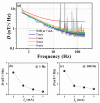Operational Parameters for Sub-Nano Tesla Field Resolution of PHMR Sensors in Harsh Environments
- PMID: 34696103
- PMCID: PMC8539847
- DOI: 10.3390/s21206891
Operational Parameters for Sub-Nano Tesla Field Resolution of PHMR Sensors in Harsh Environments
Abstract
The resolution of planar-Hall magnetoresistive (PHMR) sensors was investigated in the frequency range from 0.5 Hz to 200 Hz in terms of its sensitivity, average noise level, and detectivity. Analysis of the sensor sensitivity and voltage noise response was performed by varying operational parameters such as sensor geometrical architectures, sensor configurations, sensing currents, and temperature. All the measurements of PHMR sensors were carried out under both constant current (CC) and constant voltage (CV) modes. In the present study, Barkhausen noise was revealed in 1/f noise component and found less significant in the PHMR sensor configuration. Under measured noise spectral density at optimized conditions, the best magnetic field detectivity was achieved better than 550 pT/√Hz at 100 Hz and close to 1.1 nT/√Hz at 10 Hz for a tri-layer multi-ring PHMR sensor in an unshielded environment. Furthermore, the promising feasibility and possible routes for further improvement of the sensor resolution are discussed.
Keywords: field detectivity; magnetoresistive sensors; planar-Hall magnetoresistance; sensitivity.
Conflict of interest statement
The authors declare no conflict of interest.
Figures














Similar articles
-
Bridge Resistance Compensation for Noise Reduction in a Self-Balanced PHMR Sensor.Sensors (Basel). 2021 May 21;21(11):3585. doi: 10.3390/s21113585. Sensors (Basel). 2021. PMID: 34064121 Free PMC article.
-
Systematic Analysis of Driving Modes and NiFe Layer Thickness in Planar Hall Magnetoresistance Sensors.Sensors (Basel). 2025 Feb 18;25(4):1235. doi: 10.3390/s25041235. Sensors (Basel). 2025. PMID: 40006464 Free PMC article.
-
Serial MTJ-Based TMR Sensors in Bridge Configuration for Detection of Fractured Steel Bar in Magnetic Flux Leakage Testing.Sensors (Basel). 2021 Jan 19;21(2):668. doi: 10.3390/s21020668. Sensors (Basel). 2021. PMID: 33477948 Free PMC article.
-
Frontiers of graphene-based Hall-effect sensors.J Phys Condens Matter. 2021 May 18;33(24). doi: 10.1088/1361-648X/abf7e2. J Phys Condens Matter. 2021. PMID: 33853045 Review.
-
Superconducting Quantum Interferometers for Nondestructive Evaluation.Sensors (Basel). 2017 Dec 6;17(12):2798. doi: 10.3390/s17122798. Sensors (Basel). 2017. PMID: 29210980 Free PMC article. Review.
Cited by
-
A Survey of the Magnetic Anisotropy Detection Technology of Ferromagnetic Materials Based on Magnetic Barkhausen Noise.Sensors (Basel). 2024 Nov 27;24(23):7587. doi: 10.3390/s24237587. Sensors (Basel). 2024. PMID: 39686124 Free PMC article. Review.
References
-
- Makarov A., Windbacher T., Sverdlov V., Selberherr S. CMOS-compatible spintronic devices: A review. Semicond. Sci. Technol. 2016;31:11. doi: 10.1088/0268-1242/31/11/113006. - DOI
-
- Zhai J., Dong S., Xing Z., Li J., Viehland D. Geomagnetic sensor based on giant magnetoelectric effect. Appl. Phys. Lett. 2007;91:123513. doi: 10.1063/1.2789391. - DOI
-
- Zuo S., Heidari H., Farina D., Nazarpour K. Miniaturued magnetic sensors for implantable magnetomyography. Adv. Mater. Tech. 2020;5:2000185. doi: 10.1002/admt.202000185. - DOI
MeSH terms
Grants and funding
LinkOut - more resources
Full Text Sources
Research Materials

